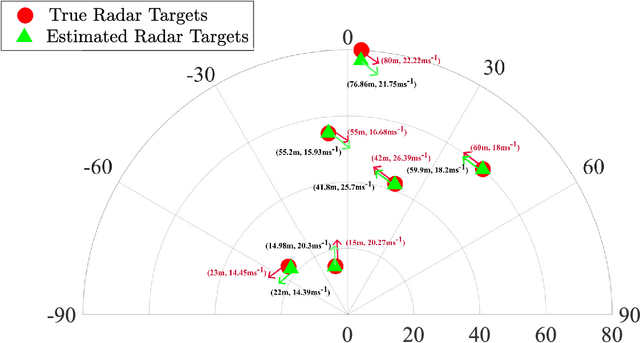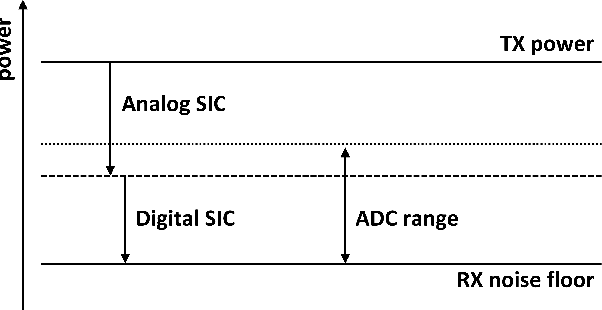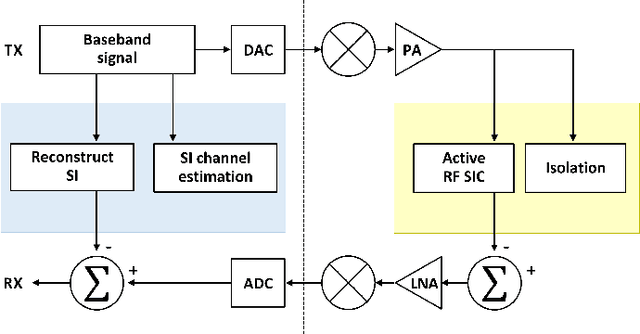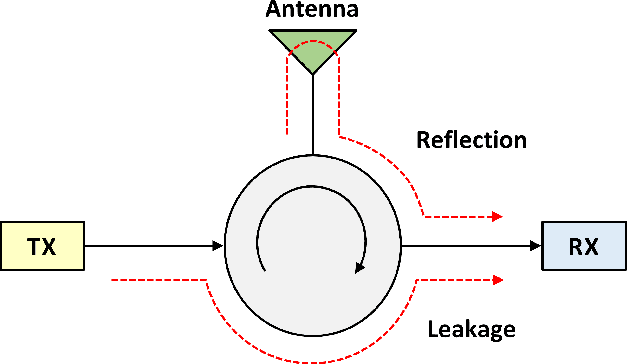Besma Smida
In-Band Full-Duplex MIMO Systems for Simultaneous Communications and Sensing: Challenges, Methods, and Future Perspectives
Oct 09, 2024



Abstract:In-band Full-Duplex (FD) Multiple-Input Multiple-Output (MIMO) systems offer a significant opportunity for Integrated Sensing and Communications (ISAC) due to their capability to realize simultaneous signal transmissions and receptions. This feature has been recently exploited to devise spectrum-efficient simultaneous information transmission and monostatic sensing operations, a line of research typically referred to as MIMO FD-ISAC. In this article, capitalizing on a recent FD MIMO architecture with reduced complexity analog cancellation, we present an FD-enabled framework for simultaneous communications and sensing using data signals. In contrast to communications applications, the framework's goal is not to mitigate self interference, since it includes reflections of the downlink data transmissions from targets in the FD node's vicinity, but to optimize the system parameters for the intended dual functionality. The unique characteristics and challenges of a generic MIMO FD-ISAC system are discussed along with a broad overview of state-of-the-art special cases, including numerical investigations. Several directions for future work on FD-enabled ISAC relevant to signal processing communities are also provided.
Integrated SWIPT Receiver with Memory Effects: Circuit Analysis and Information Detection
Mar 11, 2024Abstract:Wireless power transfer has been proposed as a key technology for the foreseen machine type networks. A main challenge in the research community lies in acquiring a simple yet accurate model to capture the energy harvesting performance. In this work, we focus on a half-wave rectifier and based on circuit analysis we provide the actual output of the circuit which accounts for the memory introduced by the capacitor. The provided expressions are also validated through circuit simulations on ADS. Then, the half-wave rectifier is used as an integrated simultaneous wireless information and power transfer receiver where the circuit's output is used for decoding information based on amplitude modulation. We investigate the bit error rate performance based on two detection schemes: (i) symbol-by-symbol maximum likelihood (ML); and (ii) ML sequence detection (MLSD). We show that the symbol period is critical due to the intersymbol interference induced by circuit. Our results reveal that MLSD is necessary towards improving the error probability and achieving higher data rates.
Multi-Target Two-way Integrated Sensing and Communications with Full Duplex MIMO Radios
Dec 16, 2023



Abstract:In this paper, we propose a multiple input multiple output (MIMO) Full-Duplex Integrated Sensing and Communication System consisting of multiple targets, a single downlink, and a single uplink user. We employed signal-to-interference plus noise ratio (SINR) as the performance metric for radar, downlink, and uplink communication. We use a communication-centric approach in which communication waveform is used for both communication and sensing of the environment. We develop a sensing algorithm capable of estimating the direction of arrival (DoA), range, and velocity of each target. We also propose a joint optimization framework for designing A/D transmit and receive beamformers to improve radar, downlink, and uplink SINRs while minimizing self-interference (SI) leakage. We also propose a null space projection (NSP) based approach to improve the uplink rate. Our simulation results, considering orthogonal frequency division multiplexing (OFDM) waveform, show accurate radar parameter estimation with improved downlink and uplink rate.
Full-Duplex Wireless for 6G: Progress Brings New Opportunities and Challenges
Apr 24, 2023



Abstract:The use of in-band full-duplex (FD) enables nodes to simultaneously transmit and receive on the same frequency band, which challenges the traditional assumption in wireless network design. The full-duplex capability enhances spectral efficiency and decreases latency, which are two key drivers pushing the performance expectations of next-generation mobile networks. In less than ten years, in-band FD has advanced from being demonstrated in research labs to being implemented in standards, presenting new opportunities to utilize its foundational concepts. Some of the most significant opportunities include using FD to enable wireless networks to sense the physical environment, integrate sensing and communication applications, develop integrated access and backhaul solutions, and work with smart signal propagation environments powered by reconfigurable intelligent surfaces. However, these new opportunities also come with new challenges for large-scale commercial deployment of FD technology, such as managing self-interference, combating cross-link interference in multi-cell networks, and coexistence of dynamic time division duplex, subband FD and FD networks.
Full Duplex Holographic MIMO for Near-Field Integrated Sensing and Communications
Mar 14, 2023Abstract:This paper presents an in-band Full Duplex (FD) integrated sensing and communications system comprising a holographic Multiple-Input Multiple-Output (MIMO) base station, which is capable to simultaneously communicate with multiple users in the downlink direction, while sensing targets being randomly distributed within its coverage area. Considering near-field wireless operation at THz frequencies, the FD node adopts dynamic metasurface antenna panels for both transmission and reception, which consist of massive numbers of sub-wavelength-spaced metamaterials, enabling reduced cost and power consumption analog precoding and combining. We devise an optimization framework for the FD node's reconfigurable parameters with the dual objective of maximizing the targets' parameters estimation accuracy and the downlink communication performance. Our simulation results verify the integrated sensing and communications capability of the proposed FD holographic MIMO system, showcasing the interplays among its various design parameters.
Simultaneous Multi-User MIMO Communications and Multi-Target Tracking with Full Duplex Radios
May 17, 2022



Abstract:In this paper, we present an Integrated Sensing and Communications (ISAC) system enabled by in-band Full Duplex (FD) radios, where a massive Multiple-Input Multiple-Output (MIMO) base station equipped with hybrid Analog and Digital (A/D) beamformers is communicating with multiple DownLink (DL) users, and simultaneously estimates via the same signaling waveforms the Direction of Arrival (DoA) as well as the range of radar targets randomly distributed within its coverage area. Capitalizing on a recent reduced-complexity FD hybrid A/D beamforming architecture, we devise a joint radar target tracking and DL data transmission protocol. An optimization framework for the joint design of the massive A/D beamformers and the Self-Interference (SI) cancellation unit, with the dual objective of maximizing the radar tracking accuracy and DL communication performance, is presented. Our simulation results at millimeter wave frequencies using 5G NR wideband waveforms, showcase the accuracy of the radar target tracking performance of the proposed system, which simultaneously offers increased sum rate compared with benchmark schemes.
Full Duplex Massive MIMO Architectures: Recent Advances, Applications, and Future Directions
May 17, 2022



Abstract:The increasingly demanding objectives for next generation wireless communications have spurred recent research activities on multi-antenna transceiver hardware architectures and relevant intelligent communication schemes. Among them belong the Full Duplex (FD) Multiple-Input Multiple-Output (MIMO) architectures, which offer the potential for simultaneous uplink and downlink operations in the entire frequency band. However, as the number of antenna elements increases, the interference signal leaking from the transmitter of the FD radio to its receiver becomes more severe. In this article, we present a unified FD massive MIMO architecture comprising analog and digital transmit and receive BeamForming (BF), as well as analog and digital SI cancellation, which can be jointly optimized for various performance objectives and complexity requirements. Performance evaluation results for applications of the proposed architecture to fully digital and hybrid analog and digital BF operations using recent algorithmic designs, as well as simultaneous communication of data and control signals are presented. It is shown that the proposed architecture, for both small and large numbers of antennas, enables improved spectral efficiency FD communications with fewer analog cancellation elements compared to various benchmark schemes. The article is concluded with a list of open challenges and research directions for future FD massive MIMO communication systems and their promising applications.
Integrated Sensing and Communication with Millimeter Wave Full Duplex Hybrid Beamforming
Jan 13, 2022



Abstract:Integrated Sensing and Communication (ISAC) has attracted substantial attraction in recent years for spectral efficiency improvement, enabling hardware and spectrum sharing for simultaneous sensing and signaling operations. In-band Full Duplex (FD) is being considered as a key enabling technology for ISAC applications due to its simultaneous transmission and reception capability. In this paper, we present an FD-based ISAC system operating at millimeter Wave (mmWave) frequencies, where a massive Multiple-Input Multiple-Output (MIMO) Base Station (BS) node employing hybrid Analog and Digital (A/D) beamforming is communicating with a DownLink (DL) multi-antenna user and the same waveform is utilized at the BS receiver for sensing the radar targets in its coverage environment. We develop a sensing algorithm that is capable of estimating Direction of Arrival (DoA), range, and relative velocity of the radar targets. A joint optimization framework for designing the A/D transmit and receive beamformers as well as the Self-Interference (SI) cancellation is presented with the objective to maximize the achievable DL rate and the accuracy of the radar target sensing performance. Our simulation results, considering fifth Generation (5G) Orthogonal Frequency Division Multiplexing (OFDM) waveforms, verify our approach's high precision in estimating DoA, range, and velocity of multiple radar targets, while maximizing the DL communication rate.
Joint Analog and Digital Transceiver Design for Wideband Full Duplex MIMO Systems
Dec 16, 2021



Abstract:In this paper, we propose a wideband Full Duplex (FD) Multiple-Input Multiple-Output (MIMO) communication system comprising of an FD MIMO node simultaneously communicating with two multi-antenna UpLink (UL) and DownLink (DL) nodes utilizing the same time and frequency resources. To suppress the strong Self-Interference (SI) signal due to simultaneous transmission and reception in FD MIMO systems, we propose a joint design of Analog and Digital (A/D) cancellation as well as transmit and receive beamforming capitalizing on baseband Orthogonal Frequency-Division Multiplexing (OFDM) signal modeling. Considering practical transmitter impairments, we present a multi-tap wideband analog canceller architecture whose number of taps does not scale with the number of transceiver antennas and multipath SI components. We also propose a novel adaptive digital cancellation based on truncated singular value decomposition that reduces the residual SI signal estimation parameters. To maximize the FD sum rate, a joint optimization framework is presented for A/D cancellation and digital beamforming. Finally, our extensive waveform simulation results demonstrate that the proposed wideband FD MIMO design exhibits higher SI cancellation capability with reduced complexity compared to existing cancellation techniques, resulting in improved achievable rate performance.
Direction-Assisted Beam Management in Full Duplex Millimeter Wave Massive MIMO Systems
Sep 15, 2021



Abstract:Recent applications of the Full Duplex (FD) technology focus on enabling simultaneous control communication and data transmission to reduce the control information exchange overhead, which impacts end-to-end latency and spectral efficiency. In this paper, we present a simultaneous direction estimation and data transmission scheme for millimeter Wave (mmWave) massive Multiple-Input Multiple-Output (MIMO) systems, enabled by a recent FD MIMO technology with reduced hardware complexity Self-Interference (SI) cancellation. We apply the proposed framework in the mmWave analog beam management problem, considering a base station equipped with a large transmit antenna array realizing downlink analog beamforming and few digitally controlled receive antenna elements used for uplink Direction-of-Arrival (DoA) estimation. A joint optimization framework for designing the DoA-assisted analog beamformer and the analog as well as digital SI cancellation is presented with the objective to maximize the achievable downlink rate. Our simulation results showcase that the proposed scheme outperforms its conventional half-duplex counterpart, yielding reduced DoA estimation error and superior downlink data rate.
 Add to Chrome
Add to Chrome Add to Firefox
Add to Firefox Add to Edge
Add to Edge